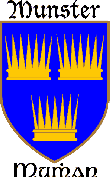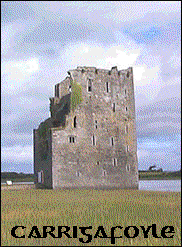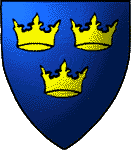
Page
Out
Records
Kerry
Links
 | ||||
| Home Page | Starting Out | Online Records | Research Kerry | Resource Links |

Note: The Roman geographer Ptolemy lived about the year 140. His chart of Hibernia (Ireland) is the basis for what little is known about the early inhabitants of the island. The extracts from Samuel Lewis' includes references to the early tribes and settlements mentioned in Ptolemy's original work.
Before Kerry was a county; The inhabitants of this tract, according to Ptolemy's chart, were in his time designated Velabri or Vellibori; "Hibernice," says Dr. O'Connor, "Siol Ebir, obviously meaning Illiberi Iberiae."They are supposed to have been descended from the Iberi of Spain, to whichtheir country lies opposite; but Camden derives their name from the BritishAber, signifying an estuary, thus making it descriptive of the nature ofthe country. The Lucanij, or "people of the maritime country," were placedby Richard of Cirencester in this county, near Dingle Bay. Ptolemy callsthem Luceni, and they appear to be the Lugadii of Irish writers, which ina general sense comprehended all the inhabitants on the southern coast, fromthe harbor of Waterford to the mouth of the Shannon, though sometimes confinedto those of the county of Waterford. The present name of the county is variouslyderived. Some trace it from Ciar, the eldest son of Fergus, King of Ulster,from whom it was called Carruidhe, or Cair Reeght, that is, "the kingdomof Ciar." According to Ledwich, it was called Cerrigia, or "the rocky country,"from Cerrig, or Carric, "a rock." Ciaruidhe, or "the rocky district on thewater," from ciar or cer, "a rock," and uidhe, or ui dha, "a district onthe water," was the present barony of Iraghticonnor, on the south bank ofthe Shannon, and from which may be derived Cerrigia and Kerry.
The chiefs of this country were called Hy Cain air Ciaruidhe, by contractionO'Connor Kerry ofCarrigafoyle Castle. This district was sometimes denominated Ciaruidhe Luachra,or "the rocky district on the great lake or water." The great portion ofthe county lying to the south of the river Mang formed, with the whole countyof Cork, the old native sovereignty of Desmond, or South Munster. On thearrival of the English, the O'Connors were in possession of the northernpart of Kerry; the middle parts were in possession of the Moriartys: thesouthern portion was occupied by the O'Sullivans, from whom the districtnamed Dunkerron barony was called O'Sullivan's country; also by the O'Donoghoes,distinguished into the septs of O'Donoghoe More and O'Donoghoe Ross, andby the O'Mahonies.

The O'Connor Kerry of Carrigafoyle
Princes of Kerry
Lords of Irachti-Connor
This was built in 1490. It was the chief tower house of the O'Connor, kings and princes of Kerry, Lords of Iraghticonnor and Lords of Tarbert. The castle was attacked many times by Elizabethan forces and finally subjugated by the army of Oliver Cromwell. The castle was abandoned in 1660.
Ancient Mumhan : Province of Munster
Province of Munster - aka Muinhneach, Mumhain, Mumhan, Mumu
Major Historical Divisions of Munster:
Ancient Kerry: Before the county system was established between the 13th and 16th centuries, clan territories, called "tuaths", defined boundaries.In ancient times, this area was home to the Ciarraige, Corco Duibne, UíCairpri Luachra and Éoganacht Locha Lein tribes. When the Cambro-Normans arrived in the late 12th century, the O'Connor Kerry held thenorth of the county, the O'Moriaritys held the middle, the O'Sullivans, O'Donoghues and O'Mahonies were in the south, and the O'Falvays and O'Sheas occupied the western Iveragh and Dingle peninsulas.

All - Ptolemy cites the Velabri or Vellibori, and theLuceni as ancient inhabitants of this area. At the coming of the Normans,the O'Connor Kerry held the north, the O'Moriaritys held the middle,and the O'Sullivans, O'Donoghues and O'Mahonies the south. By the end of the 13th century the county was subject to the power of the Fitzgerald lords of Desmond, the Fitz-Mauirce lords of northKerry, and the Irish McCarties, tanists of the elevated central and southernregions. By the mid 14th century the Fitzgeralds were Earls of Desmond overthe liberties of Kerry.
Clanmaurice- named for Maurice, the son of Raymondle Gros, an early Cambro-Norman invader. From Maurice came the Fitzmauricefamily of the area known as Lixnaw, later known as earls of Kerry. Stack'scountry is given here between Tralee and Abbeyfeale.
Corkaguiny- Dingle Peninsula was the homeland of the Corcu Duibhnefrom the 6th century. The O'Falvey sept were chiefs here from the 12th tothe 17th century. O'Shea and O'Connell are also mentioned alongside theO'Falveys. The Bowler family was also cited in this barony.
Dunkerron (North)- The O Sullivan Mor were lords in this area atthe coming of the Normans in the early 13th century. Their descendants, theMacGillycuddys (of the Reeks) are also cited here.
Dunkerron (South)- O'Sullivan's country. The O Sullivan Mor werelords in this area from the 13th century, holding these lands prior to thecoming of the Normans. O'Moriarity is cited here in the parish of Templenoeas chiefs of Aes Asdi.
Glanarought- O'gRiobta (Griffin) were chiefs centered at Ballygriffin.The McCarties were centered here in the mid 13th century.
Magunihy- O'Conghail (O'Connell) ruled as chiefs here. By the 11thcentury the O'Donaghues forced them towards the west coast, as the O'Donaghueswere driven from Cork by the MacCarthys and O'Mahanoys. The Mac Carthaigh(MacCarthy Mor) were centered at Muckross, near Killarney, south of theO'Donaghue territory. The ancient clan names of the O'Donaghue clan wereCinel Laoghaire and Clan tSealbach. The Mac Gillycuddys are also noted here.
Iraghticonnor- O'Connor of Kerry held sizable estates in north Kerry,their territory named Hy Cain air Ciaruidhe.
Iveragh- O Seaghdah (O'Shea), chiefs of Iveragh. Falvey and O'Connellwere chiefs in this area also, branching out from the Corcu Duibhne in the10th century.
Trughanacmy- O'Laeghain (O'Leyne or Lane) is given as chief of UiFerba. The MacElligott family is cited here for the parish name ofBallymacelligott. O Muircheartaigh (O'Moriarity) are cited here and in thebarony of Magunihy well before the Norman invasion.